|
|
|
How to anchor:
|
- Select a location on a chart that you would like to anchor
- Ensure the position has no under water obstructions like cables
- Check the river/seabed type listed on the chart
- Ensure your anchor is compatible with the area selected
- Check the tide and forecast to ensure you use the correct scope
- Approach slowly in to the wind or current
- Stop at the location at which you intend to drop the anchor
- Payout the anchor under control until it touches the bottom
- Slowly motor backwards while continuing to layout the anchor chain and line
- The processes of reversing away makes sure the chain and line do not pile up on top of the anchor
- Secure the anchor line when enough scope has been laid out
- A small trust of reverse will ensure the anchor 'digs in'
- Take a visual fix or use the chart plotter 'waypoint' or 'anchor watch' feature to ensure anchor has correctly held
- Only turn off engines when you are sure the anchor is not dragging
- Establish anchor watch for the duration of the stay
|
|
Anchor retrieval:
|
- Start engines and test controls. No use bringing in the anchor if the vessel is not functioning correctly
- Slowly drive towards the anchor, having a crew member take in any slack line
- Once the line is vertical in the water, take a turn around a cleat on the bow
- Continue to drive slowly forward to help break out the anchor of the river / seabed
- Bring the remaining line back onboard when the anchor is clear of the sea/river bed
- Store anchor securely
- Don't forget to wash down the anchor after use
|
|
Anchor with two anchors:
|
|
Anchoring with two anchors can be performed for one of two reasons. These are:
|
Two anchors from the bow
- Increases holding power in bad conditions
- Reduces swing range
|
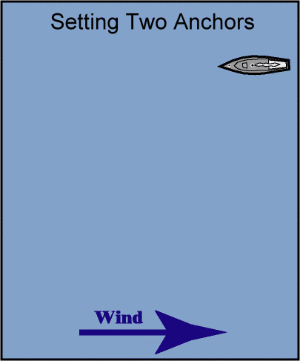
|
Bow and stern anchoring
- Holds vessel aligned in a position where space is limited
- Suitable to hold a vessel in a tidal stream like a river
- Hold a bow to waves and stern to beach
Set your primary anchor as usual, facing into the wind
- Back away and set your anchor but pay out more line than your intended scope
- Set the stern anchor behind and off one corner of the boat.
- Drop the stern anchor with minimum 5:1 scope
- Take in the slack of the stern anchor and set it.
- Adjust to the desired scope for your primary anchor while paying out line for the stern anchor as needed.
- The bow anchor should now be taut.
|
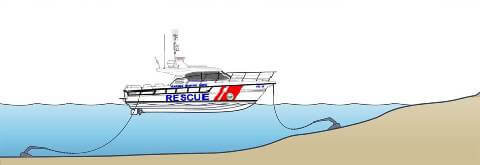
|
Scope:
Scope is defined as a ratio of the length of an anchor rode paid out to the depth of the water under the the bow of the boat measured from deck height.
The scope/ratio will need to be calculated based on the conditions at the time, or using the worst conditions forecast for the duration of the stay.
The scope forms an important part of the anchoring methodology.
Having too little scope means the holding power of the anchor will be greatly deminished.
- Wind up to 10 Knots - 5:1
- Wind 10 to 35 Knots - 7:1
- Wind over 35 Knots - 10:1
|
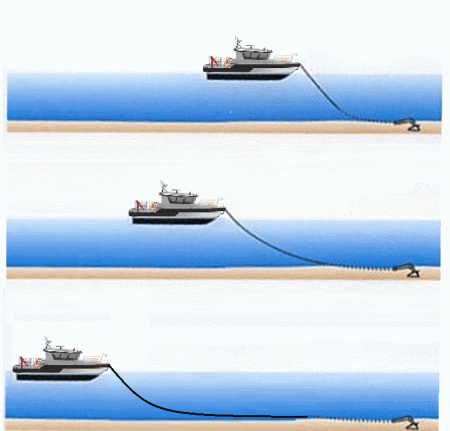
|
Some skippers would use a scope of 3:1 for very good conditions, in a falling tide for wind less than 5 Knots. Remember that leaving such a small room for error usually equals a bad day on the water.
Better to use the minimum recommended scope of 5:1 for better holding power and peace of mind for the duration of your stay.
Remember when working out the depth of the water, consider the following:
- Current depth of water
- Add any increase in tidal height to high tide
- Add the height of the bow roller above water line
|
|
Rope and chain requirements:
|

|
|
Various authorities publish tables of recommended anchor sizes, anchor ropes and chains.
These do vary, but only slightly.
The following table appears in AMSA's Safety Education Article No.33.
For a commercial vessel, the anchoring gear forms part of the survey conducted by AMSA under the national system for domestic commercial vessels.
So what is the function of the anchor chain?
The chain is used for a number of reasons. Firstly, the chain adds weight to the anchor rode/line before it reaches the anchor.
This means that it can act as a shock absorber. Every time a wave hits the bow of the vessel, the bow lifts and falls.
That action is passed down the line to the anchor.
The chain allows the pull to lift slightly and fall again on to the seabed.
Without the chain being present, the anchor would be lifted each time and would most likely break out of the seabed, then 'bounce' along the seabed as it is dragged along.
The second purpose of the anchor chain is to provide a horizontal pull on the anchor. The anchor requires the horizontal pulling force along the seabed to help it to dig in.
Without the chain, the anchor would be pulled with an attitude from the vessel that would make it unlikely to dig in correctly.
How much chain to use?
A rule of thumb is to use at least the length of the vessel, but it does come down to the weight of the vessel, the diameter of the chain etc.
Usually the outlet selling the anchor lines will have charts based on your boat type/weight to follow.
|
Parts of the anchor:
The stock turns the anchor into an attitude that enables the flukes to dig into the sea bed.
The flukes build up resistance as they bury in to the seabed.
The crown is the rounded lower section of the anchor to which the shank is secured
The shank is the long center part of the anchor running between the ring and the crown.
The tripping ring is used with optional tripping line to break the anchors hold
The stock turns the anchor so the flukes dig into the sea bed.
The tip of a fluke is called the bill.
The ring attaches to the chain.
|
|
Types of anchors
|
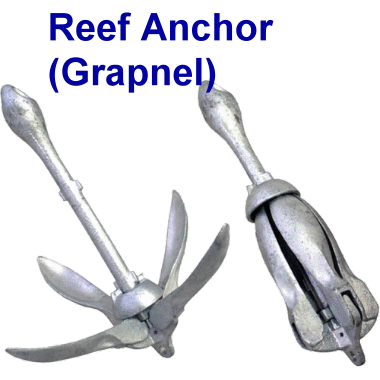
|
|
Admiralty
|
Holds well on rock and weed, but flukes are likely to drag on any other bottom. Admiralty anchors are difficult to handle and need to be extremely heavy to provide adequate holding.
|
|
|
Other names:
|
Fisherman's
|
|
|
Pros:
|
None
|
|
|
Cons:
|
Low holding power for its size..
|
|
|
Bottoms:
|
Variety but not overly good on most
|
|
Bruce
|
All-purpose anchor that performs well in most sea bottoms including mud, sand, rock, and coral. It has a harder time penetrating harder surfaces, such as clay, and bottoms with heavy grass. The three-claw design sets more easily than other anchors. It also resets easily if it is ever broken loose. The Bruce has a lower holding power per kg than other anchors, meaning you'll usually need a larger anchor than say the Delta/Wing/CQR.
|
|
|
Other names:
|
Claw
|
|
|
Pros:
|
Sets easily, performs well in most conditions.
|
|
|
Cons:
|
Struggles on heavy grass or hard clay.
|
|
|
Bottoms:
|
Sand, Mud, Rock
|
|
CQR
|
Hinged shank design makes it more responsive to wind and tide changes as compared to other anchors as it tends to "turn in a tide" rather than breaking out and having to be reset.
|
|
|
Other names:
|
Coastal Quick Release, Plough
|
|
|
Pros:
|
Good holding power, fits well on bow rollers
|
|
|
Cons:
|
Hinged design can make stowage awkward.
|
|
|
Bottoms:
|
Various except rock/coral
|
|
Delta
|
Similar to CQR, a Plough anchor that is one piece
|
|
|
Other names:
|
Wing
|
|
|
Pros:
|
Good holding power, fits well on bow rollers
|
|
|
Cons:
|
Requires large storage space due to one piece design.
|
|
|
Bottoms:
|
Various.
|
|
Danforth
|
Performs exceptionally well in mud and sand, which fortunately is what most bottoms are comprised of. Large flukes dig in easily and penetrate quickly producing excellent holding power. Excellent choice for a secondary anchor.
|
|
|
Other names:
|
Fluke
|
|
|
Pros:
|
Stows easily.
|
|
|
Cons:
|
Little holding power outside of sand/mud
|
|
|
Bottoms:
|
Sand, mud.
|
|
Plough Anchor with Roll Bar
|
Variation on a plough style anchor, with a sharper point than traditional ploughs. These anchors can penetrate the sea bottom a lot easier than the other anchor styles. The roll bar also helps them orient themselves upright when setting. Due to patents in design, these anchors are usually very expensive
|
|
|
Other names:
|
Usually called by its brand name
|
|
|
Pros:
|
Very high holding power.
|
|
|
Cons:
|
Usually expensive due to patent
|
|
|
Bottoms:
|
Various.
|
|
Grapnel
|
They fold up very compactly and are easy to stow. A Grapnel's holding power comes from hooking onto another object, such as a rock. When it does hook, it can create immense holding power, which can also make retrieving the anchor difficult. Popular with Kayaks, Dinghies, Canoes, etc.
|
|
|
Other names:
|
Hook
|
|
|
Pros:
|
Folds to conceal bills for safety
|
|
|
Cons:
|
Not appropriate for non-temporary anchorage.
|
|
|
Bottoms:
|
Rock, coral.
|
|
Mushroom
|
Mushroom anchors are often used for permanent mooring buoys with silt from the sea-bottom building up over time over the anchors. As a mooring buoy, the mushroom anchor is an excellent choice, up to 10 times the holding power of its actual weight. Not useful in some temporary anchoring situations.
|
|
|
Other names:
|
Nil
|
|
|
Pros:
|
Great for permanent mooring buoys when oversized.
|
|
|
Cons:
|
No holding power if silt build up does not occur.
|
|
|
Bottoms:
|
Any where weight builds up over anchor.
|
|
Terminology:
Anchor rode The combined anchor line and chain.
Break out the anchor To make ready and free the anchor for letting go.
Scope The ratio of amount of anchor line to depth.
Let go Lower the anchor in to the water with control (hand over hand).
Dragging anchor Anchor is scooting over and not holding to the river bed or seabed.
Weighing anchor Weighing anchor is the operation of heaving in cable until the anchor is broken out of the bottom.
Anchor aweigh The anchor has been broken out of the ground and is clear of the seabed.
Clear anchor Used when weighing anchor to indicate that it is in sight and clear of turns in the cable or other obstructions.
Foul anchor Used to describe an anchor which is caught in an underwater cable, obstruction or which is fouled by its own cable.
Bitter end Anchor attachment to the vessel.
Got her cable These are used when a vessel is riding to her anchor and cable, and the anchor is holding. Other terms used for this - Come to, Brought up.
Shortening in To heave in position of a cable, so reducing the scope
Up & down The cable is said to be up & down when the angle the cable makes with the water surface is 90°.
Yawing A vessel is said to be 'yawing' when at anchor when she moves to port and starboard of the anchor position under the influence of the wind and/or tide.
Short stay The cable is said to be short stay when the anchor is hove in close to the ship's side and not overextended. The cable is not up & down in this position. A cable is a short stay when it is leading down to the water vertically.
Long stay A cable is at long stay when it is taut and leading down to the water close to horizontal.
Lee tide A tidal stream which is setting to leeward or downwind. The water surface has a minimum of chop on it, but the combined forces of wind and tide are acting upon the vessel.
Weather tide A tidal stream which is setting to windward or upwind. The water surface is very choppy, but the forces of wind and tide are acting in opposition on the vessel.
Windlass Machine for winching the chain cable consisting of a horizontal shaft rotated by an electric motor.
Surge cable To allow the cable to run out freely, not using the brake or the windlass motor.
Snub the cable To stop the cable running out by applying the brake on the windlass.
To veer cable To pay out cable under power, by walking back the gypsy of the windlass.
Gypsy Vertical wheel on the windlass on which the cable passes over .the cable is held on the segments of the wheel.
Snubber Used when anchor pendant is all chain, works as a shock absorber and reduces vibrations from chain shuddering through the vessel.
|
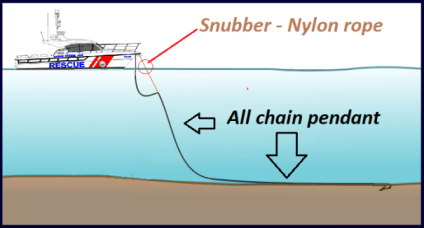
|
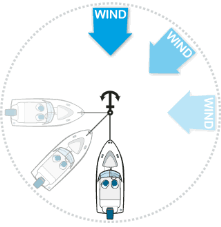
Swing range Arc of travel the vessel will move from the anchor. This is the theoretical radius in which the vessel is expected to swing when at anchor. Calculated as (Length of anchor rode plus Length of the Ship in meters).
|
|
Forces acting on an anchor:
|
|
Wind
|
Wind physically pushes the vessel and is the main cause of anchor dragging. The prospect of anchor dragging can be reduced by increasing the scope of the cable.
|
Current
|
River currents and changes in tidal flow affect the load on an anchor cable or rode.
|
Waves
|
Waves cause the vessel to pitch, yaw and heave up and down and may cause the anchor to break out.
If the anchor line is long enough, the vessel's movement due to wave action will not affect the anchor.
|
|
Drogues and sea anchors:
|
|
A sea anchor and a drogue are actually two different devices designed with different intentions.
Note: Neither a Drogue or Sea Anchor are designed to hold fast to a river or sea bed.
|
|
A sea anchor (also known as a drift anchor, drift sock, para-anchor or boat brake) is a parachute-like device designed to be set off the bow in heavy weather.
Its purpose is to stabilize the vessel by holding the bow into the wind or waves and to limit its drift through the water.
|
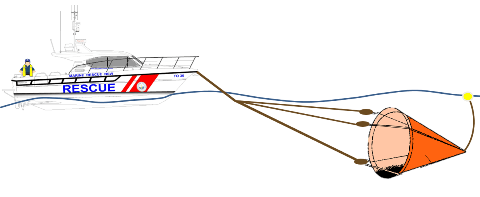
|
|
A drogue is deployed off the stern and is used to keep the boat straight while motoring with a following sea (swell from astern or behind the vessel).
By slowing the boat as it races down a wave face, a drogue reduces the chances of broaching or pitch-poling to occur.
Drogues may also be used to steer a boat that has lost its steering system by attaching to the stern cleats (port and starboard) and pulling in to the side that a turn needs to be made.
A MRNSW vessel may use a drogue when towing a vessel in heavy seas.
The drogue would be deployed off the stern of the towed (disabled) vessel to help with the alignment of the vessel and improving control and safety.
The drogue will stop the towed vessel from 'surfing' down a wave.
A drogue can be used as a sea anchor if a sea anchor is not available however will not be as effective.
|
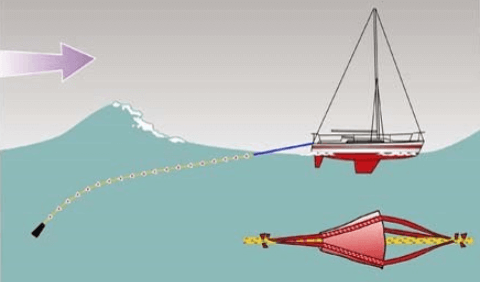
|
|
|